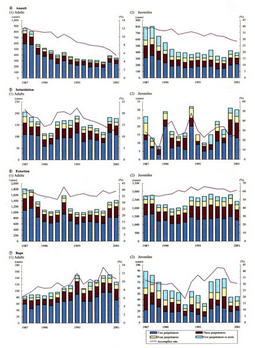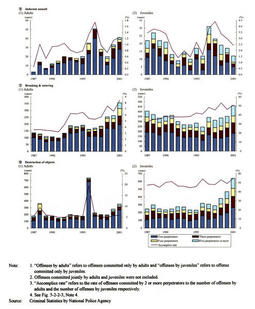| Previous Next Index Image Index Year Selection | |
|
|
3 Accomplice (1) Overall trends Fig. 5-2-3-3 shows the trends in the number of cleared cases involving accomplices, the number of accomplices in each case, and the rate of cases involving accomplices (accomplice rate), by type of offense for adult and juvenile offenders.
The accomplice rate for general penal code offenses committed by adults showed an upward trend since 1992 and it has been rapidly increasing since 2000. The accomplice rate for general penal code offenses committed by juveniles had been on the rise since 1988, showing a repeated trend of increase and decrease, but it started to decrease in 1993 and then took an upward turn again in 1999. In 2001, the accomplice rate for offenses committed by adults was about 15% whereas the rate for offenses committed by juveniles exceeded 25%. (2) Accomplice rate for homicide and the 9 types of violent offenses The accomplice rate for offenses committed by adults has remained flat without significant changes, along with the number of accomplices. The accomplice rate for offenses by adults has been about 8% whereas the rate for offenses committed by juveniles has been on the rise on a long-term basis while showing a repeated trend of increase and decrease and it exceeded 20% in 2001. In the case of offenses by juveniles, the number of cases involving 5 or more perpetrators has been increasing since 1993.
As for robbery, the accomplice rate for offenses by adults were on a constant rise since 1988, but it has been showing a repeated trend of increase and decrease since 1994 and then reached 20% in 2001. The accomplice rate for offenses by juveniles was on the rise while showing a repeated trend of increase and decrease since 1989 and it has been within the range between 66% and 78% since 1995. As for extortion, the accomplice rate for offenses by adults has generally been within a range from 35% to 40% whereas the accomplice rate for offenses by juveniles has been around 60%. The accomplice rate for extortion by adults is higher than that for robbery by adults, which indicates that extortion is more frequently committed by multiple perpetrators. As for bodily injury and assault, the accomplice rate has been showing a downward trend on a long-term basis both for offenses by adults and juveniles. As for intimidation, the accomplice rate for offenses by adults has generally been on the decline whereas the rate for offenses by juveniles has been unstable, showing a repeated trend of increase and decrease. As for rape, the accomplice rate for offenses by adults was 10.7% in 2001 and most cases were committed by 2 perpetrators. The accomplice rate for offenses by juveniles was about 30% and it should be noted that most cases were committed by 3 or more perpetrators. As for indecent assault, the accomplice rate was extremely low both for offenses by adults and juveniles: in 2001, the rate for offenses by adults was 1.2% and the rate for offenses by juveniles was 2.4%. Though both rape and indecent assault are sexual offenses, rape was frequently committed either by a solitary perpetrator or by 2 or more perpetrators whereas indecent assault is not fit to be committed by multiple perpetrators and it is likely to be committed by a solitary perpetrator. As for breaking and entering, it should be noted that the accomplice rate has been increasing both for offenses by adults and juveniles. In the case of breaking and entering by adults, the percentage of offenses by 2 perpetrators has been the largest but the percentage of offenses by 3 or more perpetrators has been increasing since 1996. As for destruction of objects, the accomplice rate has been almost flat both for offenses by adults and juveniles, with only exception of the rate for offenses by adults in 1996. Almost half of the cases by juvenile offenders were committed by multiple perpetrators. Fig. 5-2-3-3 Trends in the number of cleared cases involving accomplices and the accomplice rate (3) Actual condition of more offenses committed by groups Close examination on robbery cases committed by multiple perpetrators points out not only the increase in the number of cases committed by multiple perpetrators but also the increase in the number of perpetrators involved in 1 case. During the period between 1987 and 2001, the total number of cleared cases only doubled whereas the number of cases committed by multiple perpetrators increased significantly: the number of cases committed by 3 perpetrators increased almost threefold (279 cases), the number of cases committed by 4 perpetrators and the number of cases committed by 5 perpetrators increased almost fourfold respectively (176 cases and 110 cases), and the number of cases committed by 6 or more perpetrators increased almost eightfold, from 14 cases to 118 cases. By the distinction of offenses by adults and juveniles, the number of cases committed by 3 adult perpetrators increased almost fourfold and the number of cases committed by 5 or more adult perpetrators increased rapidly from 15 to 76, whereas the number of cases committed by 3 juvenile perpetrators increased almost threefold, and the number of cases committed by 5 or more juvenile perpetrators increased rapidly from 19 to 99. As for robbery cases jointly committed by adults and juveniles, the number of cases committed by 3 perpetrators increased from 21 to 57, and the number of cases committed by 5 or more perpetrators increased from 8 to 53.
Also as for breaking and entering, though the number of cleared cases was about 5,150 both in 1987 and 2001, the number of cases committed by 3 perpetrators increased almost by half, the number of cases committed by 4 perpetrators almost doubled, and the number of cases committed by 5 perpetrators increased almost threefold, during this period. In respect to offenses committed only by adults, the number of cases committed by 3 perpetrators almost doubled, the number of cases committed by 4 perpetrators increased almost 15-fold, and the number of cases committed by 5 or more perpetrators increased sevenfold. In respect to offenses by committed only by juveniles, the number of cases committed by 2 perpetrators and the number of cases committed by 3 perpetrators remained almost the same whereas the number of cases committed by 4 perpetrators increased almost 1.3-fold and the number of cases committed by 5 or more perpetrators increased from 60 to 103. These trends indicate the recent increase in the number of cases of robbery and breaking and entering committed by a relatively large number of perpetrators or groups. |


